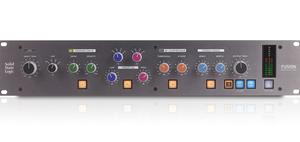- in Gear , Hardware , New Music Gear Monday , Video by Bobby Owsinski
New Music Gear Monday: SSL Fusion Stereo Buss Processor
 Ever since mixing went inside the box there’s been a debate over whether outboard hardware processing provides enough of a useful upgrade to the sound of the mix to make it worth the trouble. Outboard gear used for sweeting can include everything from a custom built summing box to individual signal chains for each main element of the mix. Could there be a better way of easily adding outboard signal processing to your DAW. SSL thought so, and has introduced its new Fusion hardware processor, which may be the first outboard processor built specifically for DAW mix enhancement.
Ever since mixing went inside the box there’s been a debate over whether outboard hardware processing provides enough of a useful upgrade to the sound of the mix to make it worth the trouble. Outboard gear used for sweeting can include everything from a custom built summing box to individual signal chains for each main element of the mix. Could there be a better way of easily adding outboard signal processing to your DAW. SSL thought so, and has introduced its new Fusion hardware processor, which may be the first outboard processor built specifically for DAW mix enhancement.
Fusion incorporates a number of sections especially tailored to sweetening a mix. There’s an input trim control, and then a high pass filter with 30, 40 and 50Hz rolloff points. These are followed by a Vintage Drive section consisting of Drive and Density controls. This section produces harmonic saturation and soft compression derived from overloading an analogue circuit, which can be used lightly for subtle thickening saturation or driven hard for more extreme distortion.
Next comes an all-new minimum phase-shift, two-band shelving EQ – the first new SSL analogue EQ circuit in more than 25 years. It’s basically a low and high frequency EQ to add some girth and sheen to a mix. Low frequency EQ points are at 30, 50, 70 and 90Hz, and high frequency points at 8k, 12k, 16k and 20kHz. Each can provide up to 9dB of boost or cut.
Next is a unique feature called a High Frequency Compressor. This is included to smooth out some of the harshness of mix, and it interacts with the previous Violet EQ section. Controls include Threshold and X-Over point that sweepable from 3 to 20kHz.
The next section is Stereo Image that’s an M/S processor that includes Space and Width controls. There also the ability to insert another outboard processor into the signal path either post or pre-EQ via two front panel buttons. Finally a switched, custom-designed SSL transformer circuit introduces low-frequency saturation alongside a high-frequency phase-shift. The result is a simultaneous thickening of the low-end and an added sparkle to the high-end.
A master Output Trim control, Bypass, and LED level indicator complete the front panel. The rear panel includes XLR inputs and outputs, as well as insert ins and outs, also on XLRs.
The SSL Fusion Buss Processor sells for $2,495. You can find out more info on the company’s website or hear some examples in the video below.

